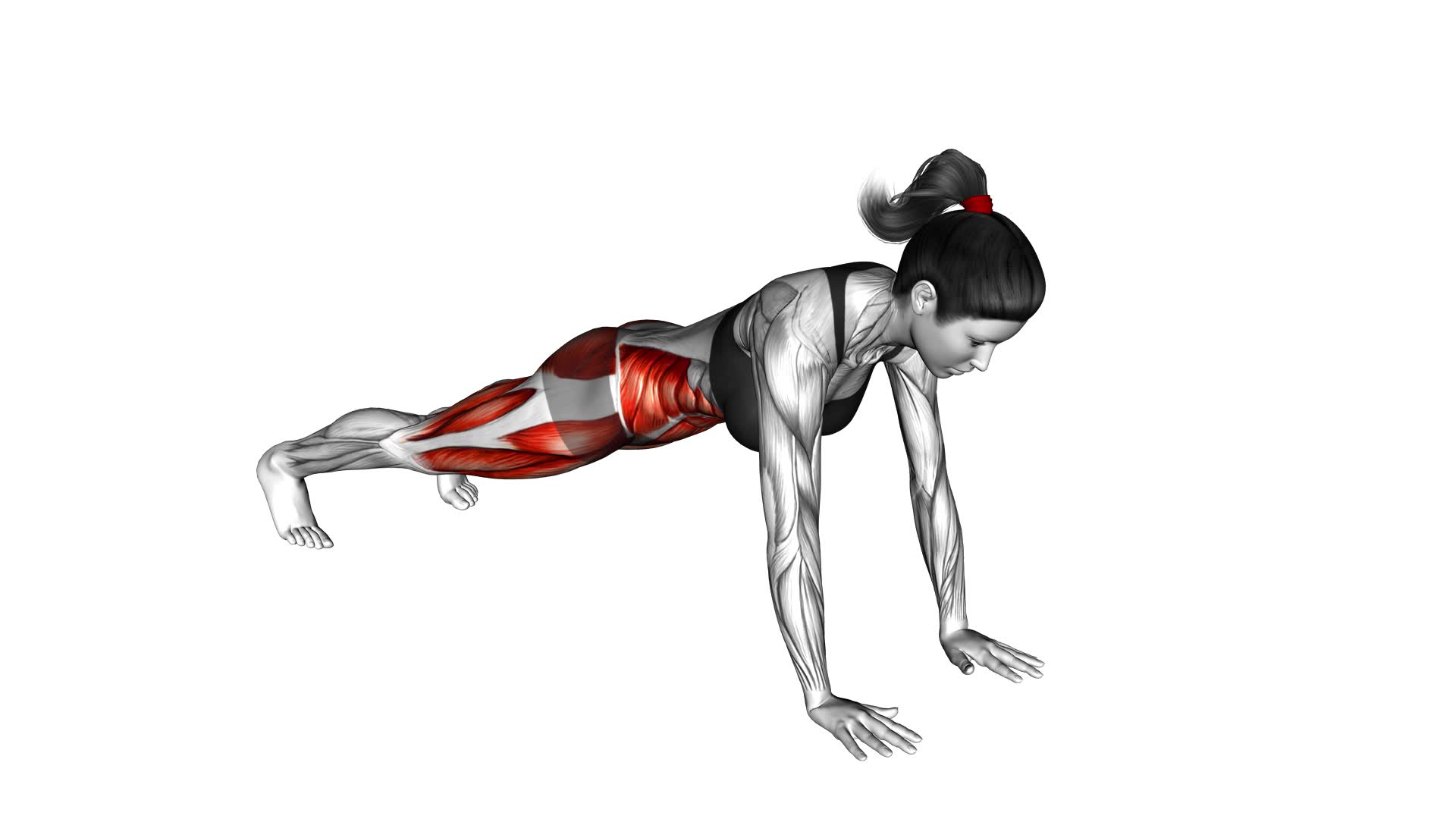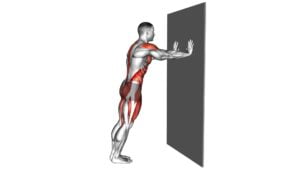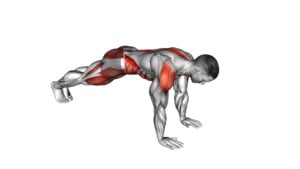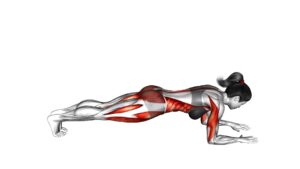Bridge – Mountain Climber (Cross Body) (female) – Video Exercise Guide & Tips

Are you looking for an effective exercise that targets multiple muscle groups and improves your overall strength? Look no further than the Bridge – Mountain Climber!
Watch This Exercise Video
In this video exercise guide, we'll show you proper form and technique for this challenging exercise. Whether you're a beginner or advanced, we have modifications and progressions to suit your fitness level.
Get ready to work your core, arms, and legs with this dynamic movement. Let's get started!
Key Takeaways
- Targets multiple muscle groups simultaneously (core, glutes, hamstrings, and shoulders)
- Allows for variations and progressions to challenge muscles
- Enhances overall fitness and well-being
- Prevents injuries
Benefits of the Bridge – Mountain Climber Exercise
Get ready to experience the amazing benefits of the Bridge – Mountain Climber exercise. This exercise offers a multitude of benefits that can enhance your overall fitness and well-being.
One of the key benefits of the Bridge – Mountain Climber exercise is that it targets multiple muscle groups simultaneously. As you perform the exercise, you engage your core, glutes, hamstrings, and shoulders, helping to strengthen and tone these areas. Additionally, this exercise also improves your cardiovascular fitness, as it requires you to move quickly and dynamically.
Another advantage of the Bridge – Mountain Climber exercise is that it can be easily modified to suit your fitness level and goals. You can adjust the intensity by modifying the speed and range of motion. For beginners, you can start with slower movements and shorter ranges of motion, gradually increasing the difficulty as you progress. Advanced practitioners can incorporate variations such as adding weight or performing the exercise on an unstable surface to further challenge their muscles.
Now that you understand the benefits and variations of the Bridge – Mountain Climber exercise, let's move on to the next section where we'll discuss the proper form and technique for this exercise.
Proper Form and Technique for the Bridge – Mountain Climber Exercise
To perform the Bridge – Mountain Climber exercise with proper form and technique, it's important to focus on core engagement throughout the movement. This means actively contracting your abdominal muscles and maintaining a stable, neutral spine position.
Core Engagement During Exercise
How can you ensure proper core engagement during the Bridge – Mountain Climber exercise?
Core engagement is crucial for stability and effectiveness during this exercise. To activate your core, start by lying on your back with knees bent and feet flat on the floor. Lift your hips off the ground, forming a straight line from your shoulders to your knees.
Engage your abdominal muscles by pulling your belly button towards your spine and squeezing your glutes. Maintain this core activation throughout the exercise.
As you bring one knee towards your chest, focus on keeping your core stable and resisting any rotation or movement. This will help you maintain proper form and maximize the benefits of stability training.
Avoiding Lower Back Strain
To avoid lower back strain during the Bridge – Mountain Climber exercise, focus on maintaining proper form and technique by keeping your core engaged and your movements controlled. This won't only help prevent back pain but also strengthen your core muscles.
Start by lying on your back with your knees bent and feet flat on the floor. Lift your hips off the ground, squeezing your glutes and engaging your core.
As you bring one knee towards your chest, keep your pelvis stable and avoid any excessive arching or rounding of your lower back. Slowly return to the starting position and repeat the movement with the other knee.
Remember to breathe throughout the exercise and keep your movements smooth and controlled.
Modifications and Progressions for the Bridge – Mountain Climber Exercise
Now let's talk about some modifications and progressions for the Bridge – Mountain Climber exercise.
If you're a beginner, there are easier modifications you can try to make the exercise more manageable for you.
On the other hand, if you're an expert looking for a challenge, there are advanced progressions that can take the exercise to the next level.
Varying the intensity of the exercise can also provide different benefits for your fitness journey.
Easier Modifications for Beginners
If you're a beginner, you can modify the Bridge – Mountain Climber exercise to make it easier. One beginner modification you can try is to perform the exercise with your hands on an elevated surface, such as a step or bench, instead of on the ground. This will reduce the amount of weight you have to lift and make the exercise more manageable.
Another option is to perform a modified version of the exercise by keeping your knees bent and your feet flat on the ground throughout the movement. This will decrease the intensity of the exercise and allow you to build strength gradually.
As you become more comfortable and stronger, you can gradually progress to the full Bridge – Mountain Climber exercise.
Now, let's move on to the next section and explore advanced progressions for experts.
Advanced Progressions for Experts
For advanced climbers looking to challenge themselves even further, try incorporating additional modifications and progressions into the Bridge – Mountain Climber exercise. Here are three advanced variations and training techniques to take your workout to the next level:
- Single-leg Bridge – Mountain Climber: Perform the exercise with one leg lifted off the ground, engaging your core and challenging your balance.
- Spiderman Bridge – Mountain Climber: As you bring your knee to your chest, twist your body and reach the opposite elbow towards your knee, engaging your obliques and increasing the difficulty.
- Plyometric Bridge – Mountain Climber: Instead of alternating your legs, explosively switch them in mid-air, adding a cardiovascular element and increasing the intensity.
By incorporating these advanced variations and training techniques, you'll continue to challenge your muscles and improve your strength and endurance.
Now, let's explore the benefits of varying intensity in the next section.
Benefits of Varying Intensity
To further enhance your workout and continue challenging your muscles, incorporate modifications and progressions into the Bridge – Mountain Climber exercise. Varying the intensity of your workouts offers several benefits and can greatly increase the effectiveness of your workout routine.
By adding modifications to the exercise, such as elevating your feet or using resistance bands, you can target different muscle groups and increase the overall difficulty. This helps to keep your workout routine fresh and prevents your muscles from adapting to the same movements, leading to better results.
Progressions, on the other hand, involve increasing the intensity gradually over time by adding more repetitions or increasing the speed of the exercise. This allows your muscles to continually adapt and grow stronger, leading to improved fitness levels.
Common Mistakes to Avoid During the Bridge – Mountain Climber Exercise
To avoid common mistakes during the Bridge – Mountain Climber exercise, make sure you maintain proper form and engage the correct muscle groups. Here are three common mistakes to avoid for injury prevention:
- Arching your back: It's crucial to keep your back straight throughout the exercise. Arching your back puts unnecessary strain on your spine and can lead to discomfort or injury. Focus on engaging your core muscles and maintaining a neutral spine position.
- Allowing your hips to sag: When performing the mountain climber movement, it's important to keep your hips level and in line with your back. Allowing your hips to sag can put excessive stress on your lower back and increase the risk of injury. Keep your core tight and your hips stable as you bring your knees towards your chest.
- Relying solely on momentum: The bridge – mountain climber exercise requires controlled movements. Avoid using momentum to swing your legs back and forth. Instead, focus on engaging your core and using your abdominal muscles to bring your knees towards your chest. This will ensure that you're getting the most out of the exercise and targeting the correct muscle groups.
Tips for Getting the Most Out of the Bridge – Mountain Climber Exercise
To maximize your results during the Bridge – Mountain Climber exercise, focus on maintaining proper form and engaging the correct muscle groups. This won't only help you avoid injuries but also maximize calorie burn. Here are some tips to get the most out of this exercise:
- Start with a proper warm-up: Before beginning any exercise, it's essential to warm up your muscles to prevent injuries. Perform some light cardio exercises, such as jogging or jumping jacks, to get your blood flowing and muscles warmed up.
- Engage your core: Throughout the exercise, make sure to engage your core muscles by pulling your belly button towards your spine. This will help stabilize your body and protect your lower back.
- Maintain proper form: Keep your body in a straight line from your head to your heels during the entire exercise. Avoid arching or sagging your back, as this can lead to strain and potential injuries.
- Control your movements: Slow and controlled movements are key to getting the most out of this exercise. Avoid rushing through the mountain climber portion and focus on bringing your knees towards your chest with control.
- Breathe properly: Remember to breathe throughout the exercise. Inhale during the bridge portion and exhale as you perform the mountain climber movement.
Sample Workout Routine Incorporating the Bridge – Mountain Climber Exercise
To incorporate the Bridge – Mountain Climber exercise into your workout routine, follow this sample workout routine:
- Warm-up:
Begin with a 5-minute cardio warm-up to get your heart rate up and prepare your muscles for exercise. You can choose activities like jogging in place or jumping jacks.
- Bridge – Mountain Climber:
Perform 3 sets of 10 repetitions on each leg. Start by lying on your back with your knees bent and feet flat on the ground. Lift your hips off the ground into a bridge position. From here, bring one knee towards your chest and extend the opposite leg straight out. Alternate legs in a climbing motion.
- Cool-down:
Finish your workout with a 5-minute cool-down to gradually bring your heart rate back down and stretch your muscles. You can do static stretches for your legs, hips, and core.
Remember to listen to your body and make any necessary workout modifications. If the exercise feels too challenging, start with fewer repetitions or take breaks as needed. As you become more comfortable, you can gradually increase the intensity and number of repetitions.
Lastly, pay attention to your breathing techniques during the exercise. Inhale during the bridge position and exhale as you bring your knee towards your chest. This will help you engage your core muscles and maintain proper form.
Frequently Asked Questions
How Many Calories Does the Bridge – Mountain Climber Exercise Burn?
The bridge – mountain climber exercise is a great way to burn calories and aid in weight loss. By combining the bridge exercise with mountain climbers, you engage multiple muscle groups and increase your heart rate, resulting in a higher calorie burn.
This exercise targets your core, glutes, and shoulders, while also providing a cardiovascular workout. Incorporating this exercise into your routine can help you achieve your weight loss goals more efficiently.
Can the Bridge – Mountain Climber Exercise Help With Weight Loss?
The bridge – mountain climber exercise is a great way to help with weight loss. It targets multiple muscle groups including the core, glutes, and shoulders, making it an effective full-body workout.
By incorporating this exercise into your routine, you can increase your heart rate, burn calories, and build strength.
It's an intense and challenging exercise that can help you achieve your weight loss goals.
Is the Bridge – Mountain Climber Exercise Suitable for Beginners?
The bridge – mountain climber exercise can be suitable for beginners with some modifications. It offers several benefits, such as strengthening the core, glutes, and upper body.
To start, focus on maintaining proper form and gradually increase the intensity. Begin by practicing the bridge exercise to strengthen the glutes and core.
Then, introduce the mountain climber exercise by performing it at a slower pace and focusing on stability. As you gain strength and confidence, you can gradually increase the speed and repetitions.
Can the Bridge – Mountain Climber Exercise Improve Core Strength?
The bridge – mountain climber exercise is a great way to improve your core strength. By incorporating these two movements, you engage multiple muscle groups simultaneously.
To properly perform this exercise, start in a bridge position with your hips lifted off the ground. Then, bring one knee towards your opposite elbow, alternating sides.
This exercise not only targets your core muscles but also helps improve stability and balance.
Incorporating the bridge – mountain climber into your routine can have significant benefits for your overall fitness.
Are There Any Variations of the Bridge – Mountain Climber Exercise for Advanced Athletes?
Looking to take your bridge – mountain climber exercise to the next level?
Advanced athletes can benefit from trying out some modifications. These variations challenge your core strength and provide additional benefits for athletes.
Incorporate movements like knee tucks, spider crawls, or adding weights to intensify the workout.
Remember to maintain proper form and listen to your body. Push yourself, but always prioritize safety and injury prevention.
Conclusion
In conclusion, the Bridge – Mountain Climber exercise is a great way to strengthen your core, improve your balance, and engage multiple muscle groups.
By following proper form and technique, you can maximize the benefits of this exercise.
Remember to start with modifications if needed and progress gradually to challenge yourself.
Avoid common mistakes and try incorporating this exercise into your workout routine for a full-body workout.
Get ready to climb mountains and conquer your fitness goals!

Author
Years ago, the spark of my life’s passion ignited in my mind the moment I stepped into the local gym for the first time. The inaugural bead of perspiration, the initial endeavor, the very first surge of endorphins, and a sense of pride that washed over me post-workout marked the beginning of my deep-seated interest in strength sports, fitness, and sports nutrition. This very curiosity blossomed rapidly into a profound fascination, propelling me to earn a Master’s degree in Physical Education from the Academy of Physical Education in Krakow, followed by a Sports Manager diploma from the Jagiellonian University. My journey of growth led me to gain more specialized qualifications, such as being a certified personal trainer with a focus on sports dietetics, a lifeguard, and an instructor for wellness and corrective gymnastics. Theoretical knowledge paired seamlessly with practical experience, reinforcing my belief that the transformation of individuals under my guidance was also a reflection of my personal growth. This belief holds true even today. Each day, I strive to push the boundaries and explore new realms. These realms gently elevate me to greater heights. The unique combination of passion for my field and the continuous quest for growth fuels my drive to break new ground.







